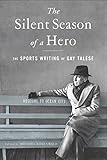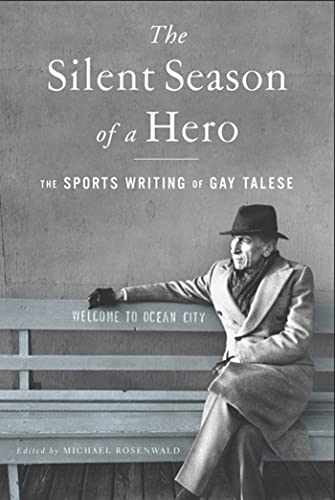 Reading The Silent Season of a Hero, a new collection of sports writing by the venerable Gay Talese, is a bit like watching time-lapse photography of a rose blooming. In the course of this 308-page book, we see a raw teenage sportswriter become a college columnist with obvious talent, then a polished reporter for a daily newspaper, and finally blossoming into a master of the long narrative form once favored by our best magazines.
Reading The Silent Season of a Hero, a new collection of sports writing by the venerable Gay Talese, is a bit like watching time-lapse photography of a rose blooming. In the course of this 308-page book, we see a raw teenage sportswriter become a college columnist with obvious talent, then a polished reporter for a daily newspaper, and finally blossoming into a master of the long narrative form once favored by our best magazines.
It’s thrilling to witness this process of maturation. Much of the credit goes to Michael Rosenwald, a staff writer at the Washington Post who selected the book’s 39 pieces and wrote short, illuminating essays that introduce each of its five sections. He sometimes quotes Talese to great effect. For instance, in praising Talese’s skill as a reporter, Rosenwald writes: “The ability to make people comfortable enough to reveal things they have never told their wives or mistresses is one of the unseen strengths of Talese’s career.” To which Talese adds, “What I think is important and what influences people to let me in the door, it’s because my manner is courteous. I want to hear about their lives. I want to listen.” In the case of the rough-edged entourage that surrounded the boxer Floyd Patterson, Talese says, “There’s a sadness about them and when someone would talk to them decently, as I did, they sort of opened up to me.”
Tom Wolfe famously touted Talese’s 1962 Esquire magazine article on Joe Louis in retirement as the piece of writing that spawned The New Journalism. Talese isn’t having it. As he explains in this book’s introduction, he had spent years prior to 1962 trying to figure out ways to use the devices of fiction – “scene-setting, dialogue, drama, conflict” – in non-fiction. He cites such specific early influences as the short stories of Hemingway and John O’Hara, “Winter Dreams” by Fitzgerald, “The Jockey” by Carson McCullers and “The Eighty-Yard Run” by Irwin Shaw. By the time he graduated from his Ocean City, N.J., high school newspaper and hometown weekly to the undergrad newspaper at the University of Alabama, he was also emulating the sports columnists Red Smith, Jimmy Cannon and Dan Parker.
It was at the New York Times from the mid-1950s to the mid-1960s that Talese’s unique penchants and gifts began to pay off. He is, in essence, an old-school reporter – but with a critical difference. He does the legwork, he has a sharp eye for the telling detail, he gets people to open up and then he writes down what they say – but along the way he also mastered what he calls “the art of hanging out.” The art of becoming part of his subject’s world. Of absorbing things until he has absorbed the essence of the story he needs to tell. The stories written for the Times often revolved around the sporting world’s invisible people, boxing referees, timekeepers, horseshoe makers, bare-knuckle fighters, agents, midget wrestlers. As good as these stories are – quirky, sharply observed, beautifully written – they’re warm-ups for the main event.
One of my favorite elements in the book is photocopies of six dense pages of notes Talese typed while getting ready to write about the New York Yankees’ final road trip in their disastrous 1979 season. Fragmentary, riddled with typos, sometimes nearly incoherent, these six pages nonetheless open a window into Talese’s creative process – how he sketches scenes, pulls together scraps of dialogue, lays out the ethnic and regional and class differences between the ballplayers and the sportswriters, even the music coming out of the players’ ubiquitous radios. It’s a string of buzzy, electric riffs, like an athlete getting pumped up in the locker room before taking the field. It’s fascinating.
 Two crucial aspects of Talese’s temperament are also revealed in this book: he is indifferent to the results of contests – to news – but he is fascinated by how those results affect the contestants. Especially when they lose. Floyd Patterson could have been speaking for Talese when he said this about the seemingly invincible Sonny Liston: “We’ll find out what he’s like after somebody beats him, how he takes it. It’s easy to do anything in victory. It’s in defeat that a man reveals himself.” (For an answer to Patterson’s musings, I refer you to Nick Tosches’s superb impressionistic little book The Devil and Sonny Liston.)
Two crucial aspects of Talese’s temperament are also revealed in this book: he is indifferent to the results of contests – to news – but he is fascinated by how those results affect the contestants. Especially when they lose. Floyd Patterson could have been speaking for Talese when he said this about the seemingly invincible Sonny Liston: “We’ll find out what he’s like after somebody beats him, how he takes it. It’s easy to do anything in victory. It’s in defeat that a man reveals himself.” (For an answer to Patterson’s musings, I refer you to Nick Tosches’s superb impressionistic little book The Devil and Sonny Liston.)
Even more fascinating to Talese than failure is the murky downslope of greatness, the twilight of storied careers, the ways stars must struggle to get their bearings after the cheering stops. This fascination led to Talese’s classic Esquire articles from the 1960s about Patterson (“The Loser”), Joe Louis (“The King as a Middle-Aged Man”) and Joe DiMaggio (“The Silent Season of a Hero”).
Eventually the cheering faded for Talese, too. When he was in his mid-sixties, half a dozen magazines turned down his brilliant article about Muhammad Ali meeting Fidel Castro in Havana, which is included here and which Talese regards as his finest piece of work. Eventually Esquire buried it at the back of its September 1996 issue.
 Talese, now pushing 80, is still working. He published a memoir, A Writer’s Life, in 2007. He has new books in the works. As for being inventor of The New Journalism, Talese says, “I have always thought of myself as rather traditional in my approach, and not so ‘new.’ I never wanted to do something new. I wanted to do something that would hold up over time, something that could get old and still have the same resonance.”
Talese, now pushing 80, is still working. He published a memoir, A Writer’s Life, in 2007. He has new books in the works. As for being inventor of The New Journalism, Talese says, “I have always thought of myself as rather traditional in my approach, and not so ‘new.’ I never wanted to do something new. I wanted to do something that would hold up over time, something that could get old and still have the same resonance.”
As this book demonstrates, that is precisely what he has done.



